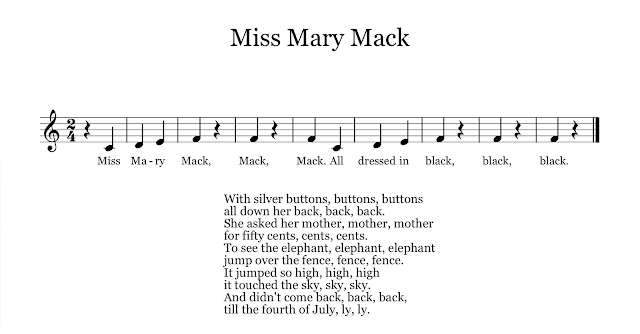One of my favorite lessons to teach every year was Miss Mary Mack. I taught the clapping game and song starting in second grade, and it was easily one of the students’ favorites. In fact, I often heard their homeroom teachers turning the lesson into a verb, as in “No Miss Mary Macking in the hallways please.” I got a secret thrill out of knowing that they were using what they learned in music outside of the classroom (even if it did drive their teachers bonkers).
Here are my top three reasons for teaching Miss Mary Mack:
- It’s a fun way for older students to practice steady beat.
- Students cross their midlines, which is vital for brain development.
- You can use it to teach and practice different tempos.
You could modify Miss Mary Mack for younger students, but I would suggest saving it for second grade or older students. In the meantime, here’s an alternative activity for crossing the mid-line with younger students. I think kindergarteners would love this!
MISS MARY MACK CLAPPING GAME
*this is the version I used, which crosses the midline more than other versions I’ve seen.
Miss
Arms crossed, touching both shoulders
Ma-
ry
Mack
Mack
Mack
The video below shows the version I always played with my students.
SEQUENCE
- To begin, students stood facing me as I taught the first three moves. I made sure to sing the words each time. If your students look as though they’ve mastered those moves, chances are, they still need several more repetitions before it’s muscle memory.
- Next, I showed students the right-hand move through mirroring. I emphasized the need for them to “cross over their midline and touch the invisible wall in front of them”.
- Then, I showed them the left-hand move, still emphasizing that “invisible wall”.
- We (very slowly) put all of the moves together, as I walked around and played the game with each student.
- In the second class, we went over all of the moves again slowly (no partners).
- Then, I had students stand in a double-line to try the first few moves with partners.
- Finally, I taught them the last clap, where they use both hands. I also showed them how the song repeats, and how to bring their arms back into that first position right after they clapped their partner’s hands.
- As they continued to practice, I had one line move down after a few repetitions so that they always practiced with someone new.
I continued to sing the song throughout. Usually my students started singing with me (unprompted). At this point, I dropped out little by little until they were singing completely on their own.

